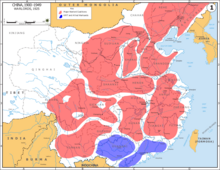
Back عصر أمراء الحرب Arabic Ера на местните военачалници Bulgarian Krigsherre-tiden Danish Warlord-Ära German Era de los señores de la guerra Spanish دوره جنگسالاران FA Sotaherrojen aikakausi Finnish Seigneurs de la guerre chinois French תקופת המצביאים HE Hadurak kora Hungarian
| Warlord Era | |||||||||||||||||||||||||
|---|---|---|---|---|---|---|---|---|---|---|---|---|---|---|---|---|---|---|---|---|---|---|---|---|---|
 Major Chinese warlord coalitions in 1925. The blue area was controlled by the Kuomintang, which later formed the Nationalist government in Guangzhou. | |||||||||||||||||||||||||
| Traditional Chinese | 軍閥時代 | ||||||||||||||||||||||||
| Simplified Chinese | 军阀时代 | ||||||||||||||||||||||||
| |||||||||||||||||||||||||
| History of the Republic of China |
|---|
 |
|
|
The Warlord Era was the period in the history of the Republic of China between 1916 and 1928, when control of the country was divided between former military cliques of the Beiyang Army and other regional factions. It began after the death of Yuan Shikai, the de facto dictator of China after the Xinhai Revolution had overthrown the Qing dynasty and established the Republic of China in 1912. Yuan's death on 6 June 1916 created a power vacuum which was filled by military strongmen and widespread violence, chaos, and oppression. The Nationalist Kuomintang (KMT) government of Sun Yat-sen, based in Guangzhou, began to contest Yuan's Beiyang government based in Beijing for recognition as the legitimate government of China.
The most powerful cliques were the Zhili clique led by Feng Guozhang, who controlled several northern provinces; the Anhui clique led by Duan Qirui, based in several southeastern provinces; and the Fengtian clique led by Zhang Zuolin, based in Manchuria. The three cliques often engaged in conflict for territory and hegemony. In mid-1917, after Yuan's successor Li Yuanhong attempted to remove Duan as premier, the general Zhang Xun forced Li to resign and made a brief attempt to restore the Qing dynasty, which was quashed by Duan's troops. Feng became the acting president, but was forced to step down by Duan in late 1918 and was replaced by Xu Shichang. In mid-1920, the new Zhili clique leaders, Cao Kun and Wu Peifu, defeated Duan in the Zhili–Anhui War in an alliance with Zhang. A power struggle broke out between Cao and Zhang, which ended with Cao's victory in the First Zhili–Fengtian War in 1922. Cao became president until 1924, when during the Second Zhili–Fengtian War he was betrayed by his subordinate Feng Yuxiang, who joined with Zhang to stage a coup against Cao. They shared power and brought back Duan to serve as president before Zhang removed them both in 1926; Zhang then led the Beiyang government until 1928.
The warlords of southern China, who had cooperated against Yuan's dictatorship and then Duan's attempt to extend Beiyang control to the south, were divided between the Yunnan, Guangxi, Guizhou, and Sichuan cliques.[1][2] Sun Yat-sen created an alternative government based in Guangzhou to oppose the Beiyang warlords, but Lu Rongting's Guangxi clique rivaled him for control, leading Sun to abandon it in 1918. In 1920, the warlord Chen Jiongming invaded Guangdong and ended Lu's control in the Guangdong–Guangxi War, after which Sun returned. Chen soon turned on Sun over disagreements on strategy, after which the Yunnan warlord Tang Jiyao helped Sun regain power in 1923. To resolve the problem of being dependent on warlords, Sun accepted Soviet assistance in building a party and military infrastructure of his own, creating the Whampoa Military Academy and the National Revolutionary Army (NRA). After Sun died in 1925, the head of the Whampoa Academy, Chiang Kai-shek, emerged as the military leader of the NRA.[3] In 1926, he launched the Northern Expedition, which destroyed the troops of the Zhili and Anhui cliques. Fengtian clique leader Zhang Xueliang retreated from Beijing, and on 29 December 1928 accepted the leadership of Chiang's Nationalist government, thus reunifying China and beginning the Nanjing decade.
Despite the official end of the era in 1928, several warlords continued to maintain their influence throughout the 1930s and 1940s, resulting in events such as the Central Plains War of 1929–1930, in which the former warlords Yan Xishan, Feng Yuxiang, and Li Zongren rebelled against Chiang. Continued regional control by former warlords was problematic for the Nanjing government during the Second Sino-Japanese War and Chinese Civil War, and contributed to the Communists' final victory in 1949. Other major warlords included the Ma clique in Gansu, Ningxia, and Qinghai; Liu Xiang and Liu Wenhui in Sichuan; Long Yun in Yunnan; Zhang Jingyao in Hunan; Zhang Zongchang and Han Fuju in Shandong; and Sheng Shicai in Xinjiang.
- ^ McCord 1993, pp. 245–250.
- ^ McCord 1993, p. 288.
- ^ Jordan, Donald A. (1976). The Northern Expedition: China's National Revolution of 1926–1928. University of Hawaiʻi Press. pp. 4–6, 32–39. ISBN 9780824880866.